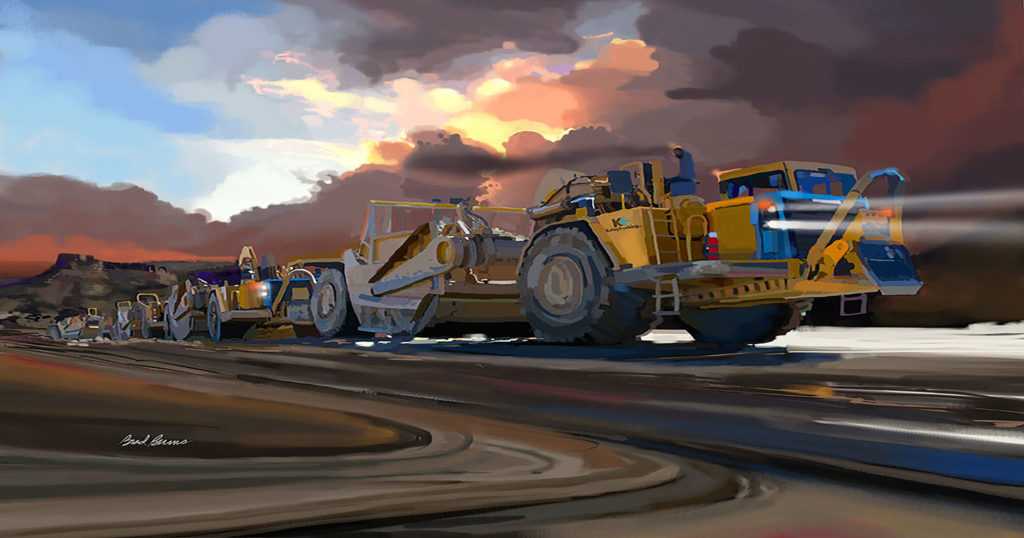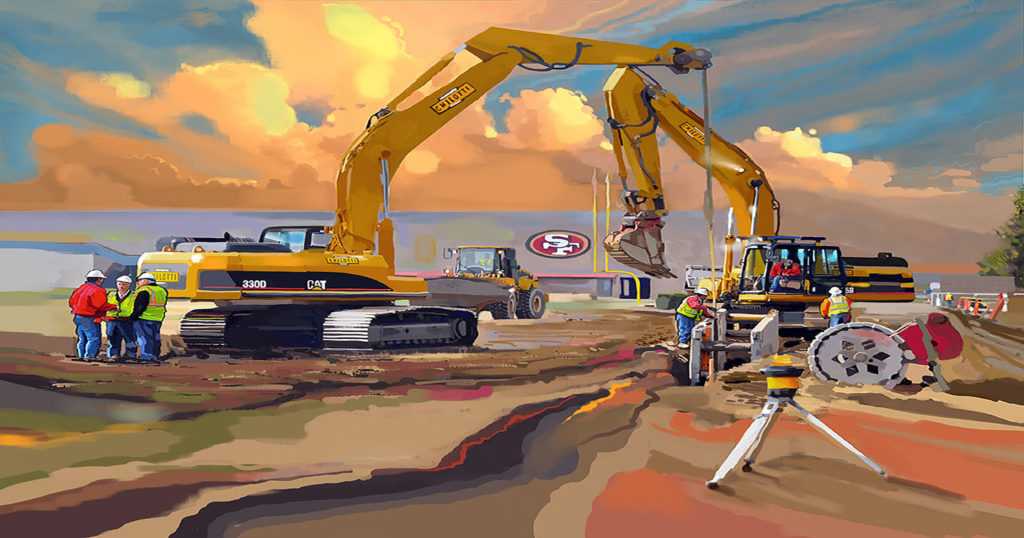When the Mud is the Muse: Selling Fine Art to Construction Clients




Every fine artist has their “thing” that speaks to them. Michelangelo found inspiration where others saw rock. Monet looked to nature and flowers. Edward Hopper enjoyed a bird’s eye, anonymous view of people doing relatable living. And for fine artist Brad Burns, it’s all about rusted metal.
As one of just a few fine artists working in the construction medium, calling him a niche within a niche may be an understatement. What is also fascinating about his muse is that he fell upon it through kismet and elbow grease.
Although he now lives in Hawaii, in some ways, Burns could be considered a quintessential “California artist,” complete with a degree in 1978 from UC Santa Cruz, where he studied art and minored in music. Upon graduation, Burns’ father took him and his portfolio to Lockheed, where his father worked, in search of a job. Lockheed had an art department that needed artists to work on projects like space renderings, and missiles. “I never did get a job with Lockheed,” he says. “But it’s really hard for an artist when you’re starting out.”
Burns admits that like so many in the fine arts fields, his initial dream was to become a rich, famous painter. But life and the responsibilities that go with it reined in some of that ambition. Burns is the father of eight children; three biological sons and five adopted daughters. His determination to keep the starving part out of his life as an artist put him in the position to work within the confines of the real world.
His talent landed him gainful artistic employment, eventually earning him a position of creative director for a high-tech firm in Silicon Valley from 1991 to 1996. Burns also continued to pursue his more artistic leanings and freelanced as an illustrator. When he was commissioned in 1994 to design a magazine cover for a construction trade group, something clicked differently. That click led to more covers that tackled similar subjects within the construction space. “People would call and say, ‘we love that,’” he says.


Expanding a Portfolio, Building a Career
That love led to the next question, one that changed his trajectory completely. Burns was told, “We’d like to have that on our walls,” he says. “Can we commission you to do the art?” One of Burns’ first commissions equates to what some might consider to be an artist’s wildest dreams. A pipeline company had built a new, huge facility. They hired Burns to “fill their building with art,” he says, a commission that equated to tens of thousands of dollars in sales. Eventually, he quit the “real world” and traded a commute for construction sites.
America is a nation that loves to create and build things. Mention the term “construction site” and most of us can recall visions of giant equipment, hard hats, or structures in production. To the untrained eye, it’s easy to overlook the potential artistic goings on at a worksite, which Burns showcases in his work where big rigs and their operators come to life on the canvas.
Laypeople might not realize this, but “there’s a lot of texture there with dirt, rocks, mud, grass, and metals,” he says. As to his thing for rusty metal, “I don’t know why, but in the textural sense, it’s beautiful.” The resulting art often presents lush paintings of machines as central characters in the story, surrounded by crews, or freshly dug up earth that a viewer can practically smell from their vantage point.
Burns has the talent, pedigree, and the chop, but part of what helps him to maintain his full-time artist venture is that these commissions start in the upper $3,000 range. Burns also maintains the rights and royalties of his work, which allows for the resale of images through his website. The smaller reprints go for a fraction of the original commission, which takes anywhere from two weeks to a month depending upon the complexity, but together, they continue to get his name and talent out there while keeping the proverbial lights on.
“It’s good for my patrons because they’re able to show their specialized skills or equipment or the work crews that do certain things that other people don’t do,” he says. “If they have that kind of art on their walls, people think they’re pretty serious about the business they are in.”
A Particular Client Base
Lewis Brooks helps to run Brooks Tractor, a third-generation family business that deals in new and used heavy machinery. His grandfather, also named Lewis Brooks, founded the Wisconsin-based operation after he returned home from World War II where he had served as a combat medic in the U.S. Army. The company originally started out as a Ford-Ferguson dealership near downtown Sun Prairie, Wisconsin, and has expanded from there. Brooks Tractor boasts seven locations throughout Wisconsin.
One key detail Brooks underscores upfront is that his family works with John Deere equipment, but it is the yellow, not the green machines. The family business deploys bulldozers, excavators, wheel loaders and the like to clients that include government entities, highway contractors, mining operations, and tree servicers. “Pretty much any kind of construction business you can think of, we probably sell something to them,” he says.
A few years ago, Brooks found Burns through a Google search for construction artists. He took a quick look at Burns’ paintings, and was excited to see that one of them included a yellow John Deere backhoe. Brooks purchased it, hung it up, and everyone liked it immediately. After a customer showed Brooks a great photo of a worksite, it was an easy decision to reach out to Burns to see if he’d recreate it on the canvas for the customer. “We sent Brad the picture, and he did an awesome job with the painting,” says Brooks. “We also got another print for the customer and they really appreciated it.”
The pair agree that their clients, “machine people,” are a fascinating lot. For starters, there is a bit of a natural rivalry between the brands Caterpillar and Deere. It’s akin to the “Ford vs. Chevy” truck debate, according to Brooks.
Enthusiasts have been known to debate the merits of one brand or company over another. Some treat their investments into construction equipment similar to how fine wine connoisseurs might display a vintage bottle, or a classic car buff would present their favorite at a show. “These guys … they do photos of their equipment, and they love what they do,” says Burns. A machine that sits at a construction site can run into the hundreds of thousands of dollars brand new, and isn’t exactly cheap used either.
After their first collaboration, a new trend began for Brooks’ family business. They quickly understood the draw of making their clients’s tellar construction site photos into fine art paintings. “We repeated our original formula for five or six other customers when the situation was right, and we were doing really well with them,” he says. The formula simply entailed getting fantastic pictures of job sites and having Burns recreate them into fine art, according to Brooks.
Art That Sends a Message
As one of Burns’ patrons who primarily commissioned him to paint pictures for his clients, Brooks took the professional relationship a step further. When the family business renovated its various locations, Brooks noted the bare walls and wanted to make the physical space more pleasant to work in. He felt the need to put something interesting on the blank walls and knew exactly what to do about it: add more of Burns’ work. “We have a lot of it right outside our main conference room,” he says. “Any time we have a meeting, people walk by it and nine times out of ten, they will compliment the artwork and ask where we got it.”
Keeping a legacy family business going is never a cake walk, but Brooks says that when they provide customers with great artwork from their projects, they are received with much gratitude. Beyond presenting a customer with a profound painting of their new rig or latest project, Burns “puts Easter eggs in the pictures,” says Brooks.
In one commissioned painting, for instance, Brooks and his family realized when they looked closer that the driver behind the big rig was none other than the company founder, his grandfather. “He found the picture of him on our website and put in the cab of the machine, all on his own,” says Brooks. “It was quite the surprise when he told us to take a closer look. So that is kind of a cool feature that made the painting more special.”
With over 200 heavy machinery paintings in his portfolio, Burns fans might be as devoted to him as they are to their specific brands of equipment. His love of the artistic inspiration found on construction sites has served him well, with many possibilities and a loyal customer base. “Even during downturns, people still need to build their roads and buildings and things,” he says.
His paint and canvas also has taken him off the construction site. He paints plenty of stills that include beach houses, seascapes, guitars, and sailing. Burns also has covered industry events like the World of Concrete conference, held annually in Las Vegas. But it is construction that puts him in a special category. “Part of being an artist is being aware of where beauty is,” says Burns. “Sometimes, you find it in the strangest places.”